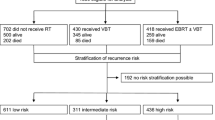Abstract
Purpose
To analyze the results of daily high-dose-rate brachytherapy (HDRBT) on local control and toxicity in the postoperative treatment of endometrial carcinoma (EC).
Materials and methods
From January 2007 to September 2010, 112 patients were treated with HDRBT after surgery for EC. FIGO staging: 24-IA, 48-IB, 14-II, 12-IIIA, 2-IIIB, 8-IIIC1 and 4-IIIC2. Pathology 99/112 endometrioid and 23/112 other types. Radiotherapy patients were divided into two groups—Group 1 (70/112) consists of external beam irradiation (EBI) plus HDRBT (2 fractions of 5–6 Gy) and Group 2 (42/112) consists of HDRBT alone (4 fractions of 5–6 Gy). Toxicity evaluation RTOG scores for bladder and rectum, and the objective criteria of LENT-SOMA for vagina. Statistics bivariate analysis of Chi-square and Fisher exact tests.
Results
With a mean follow-up of 29.52 months (range 9.60–53.57) no patient developed vaginal-cuff relapse. In Group 1 early toxicity appeared in 9 % in rectum, 8.5 % in bladder (G1–G2) and 1.4 % in vagina (G1); late toxicity was present in 8.5 % in rectum (all G1–G2 but 1 G3) and in 25 % in vagina (all G1–G2 but one G4). In Group 2, 9.4 % developed G1–G2 bladder and 6.9 % acute vagina (G1–G2) toxicity. Only 2.3 % had a G1 rectal score and 6.9 % had G1–G2 as vaginal scores for late problems.
Conclusions
(1) Daily HDRBT using two fractions of 5–6 Gy after EBI and four fractions of 5–6 Gy as exclusive treatment was a safe regime. (2) Group 1 showed a higher incidence of late vaginal toxicity.
Similar content being viewed by others
References
Nout RA, Smit VT, Putter H et al (2010) Vaginal brachytherapy versus pelvic external beam radiotherapy for patients with endometrial cancer of high-intermediate risk (PORTEC 2): an open-label, non inferiority, randomized trial. Lancet 375:816–823
Creutzberg CL, Van Putten WL, Koper PC et al (2000) Surgery and postoperative radiotherapy versus surgery alone for patients with stage I endometrial carcinoma: a multicentric randomized trial. PORTEC Study Group. Postoperative Radiation Therapy in endometrial Carcinoma. Lancet 355:1404–1411
Nag S, Erickson B, Parikh S et al (2000) The American brachytherapy society recommendations for high-dose-rate brachytherapy for carcinoma of the endometrium. Int J Radiat Oncol Biol Phys 48:779–790
Small W, Beriwal S, Demanes J et al (2012) American brachytherapy society consensus guidelines for adjuvant vaginal cuff brachytherapy after hysterectomy. Brachytherapy 11:58–67
Rovirosa A, Ascaso C, Sánchez Reyes A et al (2011) Three or four fractions of 4–5 Gy per week in postoperative high-dose-rate brachytherapy for endometrial carcinoma. Int J. Radiat Oncol Biol Phys 81:412–423
Rovirosa A, Ascaso C, Valduvieco I et al (2011) Overall interval brachytherapy treatment time in high dose rate brachytherapy (HDRBT) for endometrial carcinoma (EC). Int J Radiat Oncol Biol Phys 81:S477
Creasman W (2009) Revised Figo staging for carcinoma of endometrium. Int J Gynaecol Obstet 105:109
Guinot JL, Perez-Calatayud J, Azcoaga JM et al (2012) Consensus on treatment of endometrium carcinoma with brachytherapy of SEOR and SEFM brachytherapy group. Clin Transl Oncol 14:263–270
ICRU Report 38 (1985) Dose and volume specification for reporting intracavitary therapy in gynecology. International Commission on Radiation Units and Measurements, Bethesda
(1995) LENT SOMA scales for all anatomic sites. Int J Radiat Oncol Phys 31:1049–10191
Late Effects Consensus Conference (1995) RTOG/EORTC. Radiother Oncol 35:5–7
Sanjuan A, Cobo T, Escaramis G et al (2008) Recurrence and survival in surgically treated endometrioid endometrial cancer. Clin Transl Oncol 10:505–511
Anderson JM, Stea B, Hallum AV et al (2000) High-dose-rate postoperative vaginal cuff irradiation alone for stage IB and IC endometrial cancer. Int J Radiat Oncol Biol Phys 46:417–425
Röper B, Astner ST, Heydemann-Obradovic A et al (2007) Ten-year data on 138 patients with endometrial carcinoma and postoperative vaginal brachytherapy alone: no need for external-beam radiotherapy in low and intermediate risk. Gynecol Oncol 107:541–548
Sorbe BG, Smeds A (1990) Postoperative vaginal irradiation with high dose rate after loading technique in endometrial carcinoma stage I. Int J Radiat Oncol Biol Phys 19:305–314
Creutzberg CL, Putten WLJ, Koper PCML et al (2001) The morbidity of treatment for patients with stage I endometrial cancer: results from a randomized trial. Int J Radiat Oncol Biol Phys 51:1246–1255
Bahng AY, Dagan A, Brunner DW et al (2012) Determination of prognostic factors for vaginal mucosal toxicity associated with intravaginal high-dose rate brachytherapy in patients with endometrial cancer. Int J Radiat Oncol Biol Phys 82:667–673 (epub ahead of print)
Kucera H, Vavra N, Weghaupt K (1990) Benefit of external irradiation in stage I endometrial carcinoma: a prospective clinical trial of 605 patients who receive postoperative vaginal irradiation and additional pelvic irradiation in the presence of unfavorable prognostic factors. Gynecol Oncol 38:99–104
Chomg I, Hoskin PJ (2008) Vaginal vault brachytherapy as a sole postoperative treatment for low-risk endometrial cancer. Brachytherapy 7:195–199
Becker M, Malafy T, Bossart M et al (2011) Quality of life and sexual functioning in endometrial cancer survivors. Gynecol Oncol 121:169–173
Greven K, Winter K, Underhill K et al (2004) Preliminary analysis of RTOG 9708: adjuvant postoperative radiotherapy combined with cisplatin/paclitaxel chemotherapy after surgery for patients with high-risk endometrial cancer. Int J Radiat Oncol Biol Phys 59:168–173
Gaztañaga M, Cambeiro M, Villafranca E et al (2011) Long-term results of 1-week intravaginal high-dose-rate brachytherapy alone for endometrial cancer. Brachytherapy 11(2):119–124 (epub ahead of print)
Eiriksson L, Cuartero J, Steel H et al (2010) Assessment of outcomes in surgical staged I/II endometrial adenocarcinoma patients treated with postoperative vaginal vault radiotherapy only. Int J Gynecol Cancer 20:1356–1362
Conflict of interest
There is no conflict of interest in relation to this manuscript.
Author information
Authors and Affiliations
Corresponding author
Rights and permissions
About this article
Cite this article
Rovirosa, A., Valduvieco, I., Ascaso, C. et al. Daily schedule for high-dose-rate brachytherapy in postoperative treatment of endometrial carcinoma. Clin Transl Oncol 15, 111–116 (2013). https://doi.org/10.1007/s12094-012-0893-0
Received:
Accepted:
Published:
Issue Date:
DOI: https://doi.org/10.1007/s12094-012-0893-0



